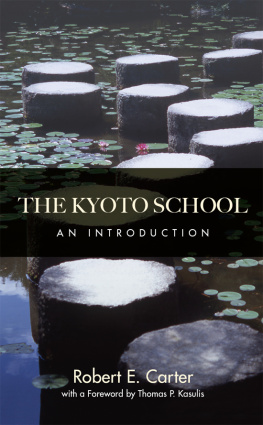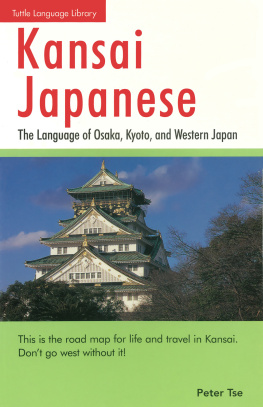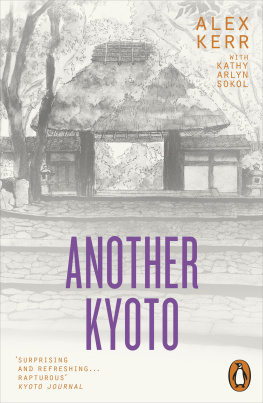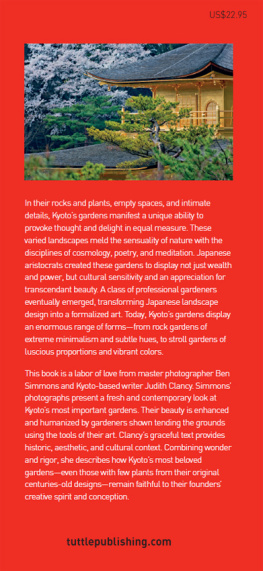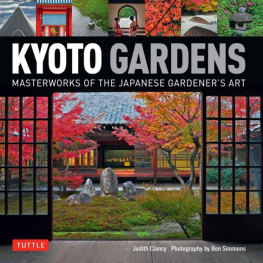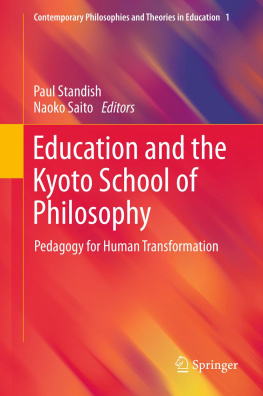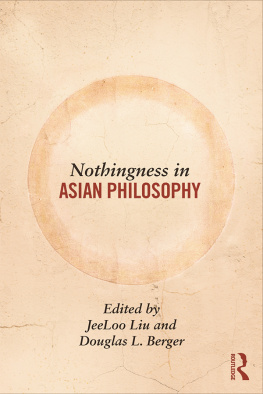The Kyoto School
An Introduction
Robert E. Carter
with a Foreword by
Thomas P. Kasulis

Cover image courtesy of the author.
Published by State University of New York Press, Albany
2013 State University of New York
All rights reserved
Printed in the United States of America
No part of this book may be used or reproduced in any manner whatsoever without written permission. No part of this book may be stored in a retrieval system or transmitted in any form or by any means including electronic, electrostatic, magnetic tape, mechanical, photocopying, recording, or otherwise without the prior permission in writing of the publisher.
For information, contact State University of New York Press, Albany, NY
www.sunypress.edu
Production by Kelli Williams-LeRoux
Marketing by Michael Campochiaro
Library of Congress Cataloging-in-Publication Data
Carter, Robert Edgar.
The Kyoto school : an introduction / by Robert E. Carter; foreword by Thomas P. Kasulis.
pages cm
Includes bibliographical references and index.
ISBN 978-1-4384-4542-7 (pbk. : alk. paper)
ISBN 978-1-4384-4541-0 (hardcover : alk. paper)
1. Philosophy, Japanese20th century. 2. Nishida, Kitaro, 18701945. 3. Tanabe, Hajime, 18851962. 4. Nishitani, Keiji, 1900 5. Nothing (Philosophy) I. Title.
B5241.C37 2013
181'.12dc23
2012011074
10 9 8 7 6 5 4 3 2 1
For Deanie, Pal, and Rita

Foreword
Thomas P. Kasulis
In this book Robert E. Carter performs a great service to the study of modern Japanese philosophy in the West. To appreciate the significance of his contribution, it is useful to begin by reviewing briefly the introduction of modern Japanese philosophy to the English-reading audience. In the years following World War II, a few translations of modern Japanese philosophical worksa couple of books and several papers in scholarly journalsbegan to appear in English. In the next decade or two, several more volumes of translations appeared, the writings of Nishida Kitar (18701945), Japan's most famous modern thinker and the founder of the so-called Kyoto School of philosophy centered in Kyoto University. The effects of those early translations were subtle, not attracting much attention from Western philosophers. Yet, the translations did provide resources, however limited, for the occasional interested Western reader. Moreover, once the interest in Japanese philosophy began to grow in the West, there was a foundation on which to build.
With Japan's rise in the 1970s and '80s as a global economic power, a curiosity about Japanese thinking took hold in the West, and a broader audience began to wonder what Japan might offer on the philosophical front. While many Anglo-American philosophers still resisted the invitation to engage any thought originating in languages other than English, others were not so provincial. Furthermore, there were Christian philosophical theologians interested in interreligious dialogue. The roots of such dialogue go back at least to the discussions begun by D. T. Suzuki and Alan Watts, but after Suzuki's death in 1966, philosophical theologians sought an East-West encounter more sustained and probing. The publication of the English translation of Nishitani Keiji's Religion and Nothingness in 1982 quickly became a focal point for Buddhist-Christian dialogue, and it led to a broader interest in the Kyoto School by Western Christian theologians. By the end of that decade, there were enough materials available in English that Robert Carter was able to write his first book addressing the Kyoto School: The Nothingness Beyond God: An Introduction to the Philosophy of Nishida Kitar (Paragon House, 1989). I was pleased when Bob asked me to write the Foreword for that volume since it was a benchmark study for modern Japanese philosophy in the West: a Western philosophical ethicist was able to engage Nishida's philosophy in an insightful and provocative way on its own terms based entirely on works available in Western languages. Since then, Carter has spent the bulk of his time working with Japanese materials, both in commentaries and as a co-translator, providing many fresh perspectives on an array of ideas from Japanese thought, both modern and traditional. Meanwhile, translations of Kyoto School thinkers have continued, and there are also at least a dozen more scholarly books in English on some aspect of the Kyoto School, most notably James W. Heisig's groundbreaking Philosophers of Nothingness (University of Hawaii Press, 1991).
As the scholarly works in English now accumulate, there is a call for a good, concise, accurate introduction that will map the intellectual terrain. We need an appropriate starting point so readers new to the field will get a sense of what is available and be able to decide for themselves what interests them and where to turn next for deeper study. This is where the present volume finds its niche. It is what is called in Japanese a nymon, a term for introduction that literally means entry gate. Every great Japanese institution has a nymon. For example, one readily thinks of the mountain gates giving access to Zen temples, the torii at the entrance to Shint shrines, and the entries to every major Japanese academy such as the Red Gate leading to the heart of the University of Tokyo. A nymon has three main functions: to give access to outsiders, to define the boundaries of a place or field, and to be an invitation to enter more deeply into its heart. The term nymon is, therefore, appropriate to an introductory work in philosophy. Many of Japan's great modern philosophers, including Nishida Kitar and Tanabe Hajime (each the focus of a chapter in the present work), wrote a tetsugaku nymon, an introduction to philosophy. The Japanese assumption is that writing such a work is not a task for a young scholar, but, rather, is to be reserved for one who has developed an expert knowledge gleaned from many years in the field. Robert Carter has reached that point in his career, experienced enough to have seasoned insights of his own, but not so far from his own first entry that he has forgotten the importance of the nymon. Thus, his book serves as an excellent introduction to the Kyoto School.
In that same spirit of nymon, as a historian of Japanese philosophy, I will offer a few comments how each of the four philosophers in this book related to premodern Japanese thinkers. As Carter explains, the modern period in Japanese philosophy was not only a departure from the past triggered by the influx of Western thought, but also a return to ideas and values traditional to Japanese culture for many centuries. So, how exactly did each of the four philosophers relate to specific premodern Japanese or East Asian thinkers? A few details may help contextualize the situation for the reader new to Japanese philosophy.
Nishida Kitar. In many ways, Nishida's links to the premodern Japanese philosophical tradition are the least obvious of the group. Of the four philosophers discussed in this book, he is the only one not to have written at least one volume explicitly about a premodern Japanese thinker. His direct references to Asian thought are few and far between and, more often than not, not much more than an epigram or phrase such as his repeated references to the form of the formless from the Buddhist (and Daoist) tradition. For example, Nishida almost never mentioned Dgen (12001253), whereas the other three modern philosophers in this book all wrote about Dgen, indeed, often extensively. Since Dgen is generally considered today to be one of the two or three most philosophical thinkers of premodern Japan, Nishida's omission may seem puzzling. Did he simply, like his lifelong friend, D. T. Suzuki, not like Dgen's thought? Nishida once wrote that if he were banished into exile and could take only two books with him, they would be the
Next page
